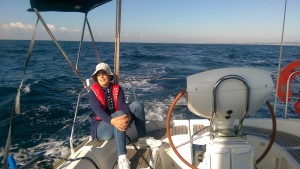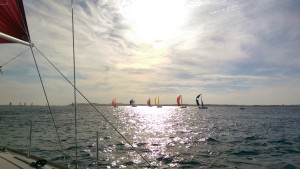Archive for April 2016
We had another memorable week at Port Stephens for the annual Sail Port Stephens regatta. This year we joined in the race from Newcastle to Port Stephens on the day before the regatta. This was our first Category 4 offshore race and the low seas and light conditions made it a very easy one. We pretty well matched a Beneteau 36.7 which is good benchmark for us but were well beaten by the Jeanneau Sunfast 37 with a huge overlapping genoa. The regatta proper started with the Commodores Cup and an offshore race around the three islands off Port Stephens. We were caught out by the fresh breeze and struggled with an oversize genoa. A reef in the main helped but we scored an own goal when we shook out the reef prematurely. The handicapper had some pity on us and as the breeze lightened for the next two races we scored a second and third for a fourth overall. The last race was a beat up the bay and a beat back as the breeze and tide changed in unison. In the smaller sub group of the Jeanneau yachts we were punished less by the first race result and won on a countback. That won for us our third bucket from Port Stephens and the three are stacked into the one shelf in the family room. The Port Stephens Regatta proper started on the Thursday with the first of two offshore races. Both were sailed in good conditions. In the first we were lucky to spot the fleet leaders becalmed and sail around them. The second was a long beat out and rewarded the yachts that has the courage to take the header all the way into the north side of the bay to escape the tide. We were not so courageous. The last race in the bay had a couple of triangles with a lot of spinnaker work. We picked the breeze on the first windward work but missed the big right shift from the approaching rain on the second. We carried the mighty asymmetric on the way home and mowed down the Sunfast 37 which carried only a large genoa on the leg. It was tight but a terrific leg made all the better by the leaders falling into a hole on the finish line. In the tight racing the handicappers achieved a good result as we were just 27 seconds out of third place overall. For the sake of 27 seconds we went from third to eighth in the regatta. The asymmetric spinnaker is working much better since we took it off the furler. The extra luff length without the top swivel and bottom furler drum and gear means the luff can be carried straighter.
Because three crew are going to Mexico for the Laser Masters Worlds we did a one day motor sail from Port Stephens back to Sydney. The breeze was too far south so we motor sailed with a double reefed main and entered Sydney Harbor at 8pm. Today there was enough sun to dry out the spinnakers on the back lawn and to appreciate how big is our awesome asymmetric kite.
Just a quick post to show photos of the cabin beams that are now installed on our Didi 40 Cr. All the prefabricated beams and beam clamps have been used so progress will appear a little slower while I complete the framing for the sloping cabin front.
The beam in front of the companionway has an unsupported span of only 600 mm and locks into the fore and aft frames that form the head and quarter berth ante room. I made these of 12 mm plywood so the structure is very solid
The timber that joins the cabin sides to the cabin top has been glued into notches in the frames and three additional laminated roof beams have been fitted. All of a sudden the cabin is taking shape. As a bonus I am slowly getting back some space in the garage as the five laminated roof beams move to the cabin top. The eight beams were laminated at the time I cut out the plywood frames. Three beams were needed to attach to the frames and I produced the additional five using the same jig.
The first frame in from the companionway sits on the fore and aft plywood frames that form the sides of the head and the quarter berth ante room. This beam had to be installed before the beam clamp at the cabin edge so that the beam clamp can fit in notches in the laminated cabin beams. The rest of the laminated frames have no structure under them and they can be lifted into place. Cutting the notches in the laminated beams is a work of art. The notches slope two ways and have rounded inside edges to match the routered edge of the beam clamp. Patience is important and my legs are sore from climbing in and out of the boat test fitting the notches to the clamps. A cutting blade on a multipurpose tool has been very useful for trimming the timber carefully to shape.
I have adjusted the laminated beam spacing slightly to suit the hatches available in Australia. They connect only to the beam clamp and one set of beams that run down to the carlins so moving them a little has no impact on other aspects of the structure.
Two more beams to go and I will start working on the sloping front of the cabin top.
At times I feel that I am not building a yacht but am just making sawdust. With help from Kevin we made the triangular shaped carlins out of a 70 mm by 22 mm rectangular section. It took a while to work out a cutting sequence but once into production mode we cut three lengths which I subsequently scharf joined into two six metre lengths, one for each side of the deck. I had pre dressed the timber but each length had to have one last check for straightness and a few passes with the power planer. All of this produces sawdust. The worst job was trimming back the excess plywood on the inside edge of the deck. The internal curve is not too power plane friendly so I used a coarse disk on the angle grinder for the trimming. To be a good neighbour I covered the cabin with a tarpaulin to keep the dust contained and donned a face mask and goggles. For the final pass I went for a fine disk and am pretty pleased to have that job behind me. The vacuum cleaner was then used to collect all the dust from the deck before it blew away in the breeze. Elaine helped me clan up the sawdust from the circular saw bench and power planer and that filled half a good sized garbage bag.
The photos of the starboard side carlin give a good view of the side deck. The foredeck and part of the forward side deck is made from two layers of 6 mm ply while the rest of the side deck is one layer of 12 mm ply.











